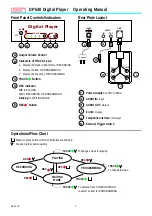
M2 User's Manual V 1.0 Revised 4/21/2003
Page 15
PRI
- Messages can be enabled or disabled using this command. Normal conditions will warrant
each message to have “1” priority meaning they are active. If a message is set for “0”, then it is
considered inactive and will not be played in the sequential mode or when a PLY command is
issued relating to that message number.
Syntax;
PRI
msgnumber,status
Where;
msgnumber
is the message location<1-255>
status
is the priority, 1 for Enable, 0 for Disable, S for Scan.
Example;
PRI5,0<CR><LF> will disable message 5.
Each message will default with a priority of 1 or enabled after it is recorded. Disabled messages
are displayed with a D in front of the message number when the message directory is listed.
Disabled messages cannot be played until they are enabled. Scan duplicates the function of the
BLD command in that it scans the system and builds a message file index.
RST -
This command causes a warm reset of the M2 system.
Example;
RST<CR><LF>
SHP
- This command allows the user to delete the entire contents of the memory and reset system
settings to factory default. This command will erase the entire memory and reset all of the
configurable settings to those specified in the Product Specification.
Example;
SHP<CR><LF>
Because of the time required to erase FLASH memory, the system may take up to 10 seconds
before becoming available to receive new commands.
STP
- Stop message playback
Syntax;
STP
channel
Where;
channel
is the channel, 1 or 2 or A(M2.1+1 only), that you want to stop. Entering no channel
value or A(ALL) stops all channels from playing.
Example;
STP1<CR><LF> will stop message playback on channel 1.
STS
- This command toggles the display of RS-232 feedback from the M2 ON or OFF. With Status
ON, the system will send a message to the RS-232 port indicting that the particular message
has stopped. This status may be used to control other systems based on the mode of the M2.
Example;
STS
value
<CR><LF>







































